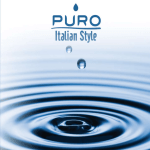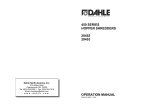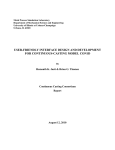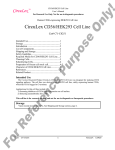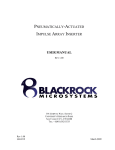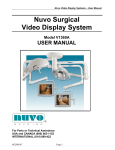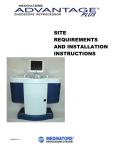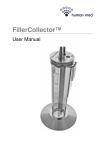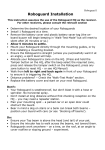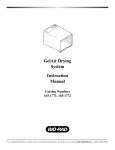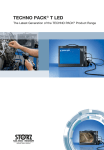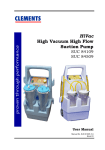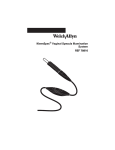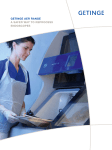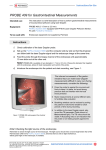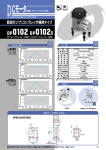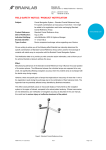Download UniARM User Manual - Mitaka USA Mitaka USA
Transcript
UniARM Surgical Support System Operating / User Manual Version 1.1 MITAKA KOHKI Co., Ltd. 1. Introduction Introduction Thank you for purchasing the UniARM for use in surgical procedures. To use the device correctly and safely, please read and understand this instruction manual thoroughly. If you have any questions or find any problem, contact your dealer, the manufacturer: Mitaka Kohki, or the distributor: Mitaka USA, Inc. The manufacturer and distributor contact information can be found at the end of this manual. This instruction manual is intended for doctors and those concerned with operating theaters who have a solid knowledge of medical equipment. Important The manufacturer will not be held responsible for any accident or fault caused by operation, maintenance, or instruction by a person who does not have adequate knowledge or training about this specific device. Furthermore, the device is not warranted against faults or damage caused by using the device incorrectly or performing prohibited actions. As it is impossible for this instruction manual to describe everything that cannot or must not be done with this device, the user should do only what is described as possible in this manual and nothing more; other actions should be considered impossible or prohibited. Only persons approved or trained by Mitaka Kohki may perform assembly, repair, maintenance, inspection, and other engineering services on this device. For maintenance and repairs (engineering services), use only genuine parts specified by the manufacturer. The manufacturer will not be held responsible for any accident or fault caused by attaching a non-genuine part. If any technical problem not described in this instruction manual occurs, immediately report it to Mitaka Kohki, stating the model name and serial number of the device. Intended Use This device keeps a laparoscope and various other endoscopes and instruments in their intended positions during a surgical operation. -1- Warning Before using the device, read and understand this instruction manual thoroughly. Do not use the device for other than its intended purpose. Allow only an experienced operator to use the device. Check the device before performing a surgical procedure. If the device seems abnormal, immediately stop using it and contact your dealer, Mitaka Kohki, or Mitaka USA, Inc. Contact information is contained at the end of this manual. Be sure to use the manufacturer-specified drape for surgical procedures. Use the device in a balanced state. If an instrument attached to the device is replaced, check the balance of the device and adjust if necessary Do not attach instruments exceeding the maximum load. Adjust the gas supply pressure to 6 to 8 kgf/cm2 (90 to 115 psi). Lock the base except when transporting the device. Do not alter the device. Precautions The symbols marked on the device have the following meanings: Warning Incorrect handling by ignoring this precaution may result in death or serious physical injury. Caution Incorrect handling by ignoring this precaution may result in physical injury or damage to property. The symbols marked on the device are accompanied by precautions where special care is required. Be sure to follow the precautions. Failure to do so may result in injury to a worker or a nearby person, or damage to the device. -2- 2. Table of Contents 1. 2. 3. 4. 5. 6. 7. 8. Introduction ....................................................................1 Table of Contents ............................................................3 Names of Each Component ............................................4 Main Function & Basic Operation .................................5 4–1 Securing the Base ............................................5 4–2 Nitrogen Gas Supply........................................5 4–3 Hand Grip.........................................................6 4–4 Holder ...............................................................6 4–5 Balancing..........................................................7 4–6 Elevation of Support Pillar ..............................8 4–7 Arm Position ....................................................8 Drape (Sterilized Disposable Cover) ..............................9 5–1 Draping .............................................................9 Sterilization of UniARM Endoscope Holders .............. 11 Maintenance and Storage ............................................14 Other Precautions ........................................................14 -3- 3. Name of Each Component 1. 2. 3. 4. 5. 6. 1. Hand Grip 2. Holder 3. Elevating Column Handle 4. Weight 5. Elevating Column System 7. 6. Base 7. Base Jack 8. 8. Caster 9. Gas Supply Plug 9. -4- 4. Main Functions and Basic Operations 4 - 1. Securing the Base Lock the base so that the device will not move during operation. When locking the base, note that the entire device will move up or down slightly because of the structure. Base Jack Knob Turn the knob to lock the base. Keep the base locked except for moving. 4-2. Nitrogen Gas Supply This device uses nitrogen gas pressure to unlock the joints. Adjust the gas supply pressure in the range of 6 to 8 kgf/cm2 (90 to 115 psi). Nitrogen Gas Supply Tube Connect to the nitrogen gas output plug in the operating theater. Gas Plug When this is connected, the joint is automatically locked. To disconnect, pull out the plug while sliding its collar outward. Optimum gas pressure 6 to 8 kgf/cm2 (90 to 115 psi) Basic Operating Procedure 1. Adjust the nitrogen gas pressure in the operating theater to 6 to 8 kgf/cm2 (90 to 115 psi), connect the nitrogen gas supply tube, and open the valve in the operating theater. (If nitrogen gas is not available, use the air compressor which is sold separately.) -5- 2. Press the switch at the hand grip to unlock the joints. At any arbitrary position, release the switch to lock the joints. 4-3. Hand Grip The hand grip has two brake release buttons. Pressing the buttons together unlocks all of the five brakes. Releasing either button locks the brakes. Brake Release Button 2 Ball Joint Lock/release Lever Tip Ball Joint (manual lever) Brake Release Button 1 Holder For easy operation, press Brake Release Button 2 first with your palm, then press and release Brake Release Button 1 using your forefinger. The tip ball joints can be moved manually by hand when the lever is released. Caution: Always lock the lever after adjusting the ball joint. 4-4. Holder A removable holder can be attached to the tip of the UniARM. Select a holder of an appropriate shape for the instrument (endoscope, retractor) to be attached to the UniARM. Sterilize the holder by autoclave as instructed in Section 6 of this manual on page 11. Endoscope Holders -6- 4-5. Balancing Warning Balance the UniARM before use. If it is out of balance, ease of operation will be reduced and a serious accident may occur. Balance the UniARM after attaching any instrument (endoscope, retractor). Balancing Weight Rotate the weight to adjust the balanced condition so the arm floats. It is based on the seesaw principle; i.e. rotate the weight by hand while checking the balance. The weight consists of several disks. A wider range of balancing is possible by changing the number of disks. -7- 4-6. Elevation of Support Pillar By turning the ascend/descend handle, the UniARM support can be moved 300 mm up and down for a wider range of positioning. Ascend/descend Handle 4-7. Arm Position The arm of the UniARM has a high degree of freedom and can be used at various positions. Arm at the up position Arm extended at the down position -8- 5. Drape (Sterilized Disposable Cover) Warning When using the device for a surgical procedure, be sure to cover it with a disposable sterile drape. Otherwise, the patient may be seriously injured. NEVER reuse disposable sterile drapes. Drape for the UniARM only: The drape must not be reused. Check that there is a drape in stock for the next surgical operation. Marked Side Transparent Side 5-1. Draping Before attaching a holder and endoscope or other part to the UniARM, cover the device with a drape. 1. Opening the bag Open the bag on the side marked with an arrow. 2. Removing the drape -9- 3. Covering the device with the drape Spread the drape from where it says "Spread from here" and cover the UniARM. After covering the device entirely with the drape, remove any slack by using blue tape, but without restricting the movement of the device. Check that the drape does not hinder operation of the 4. Attach a sterilized holder Attach a sterilized holder from outside the drape. Caution The maximum weight of an instrument that can be attached to a holder is 3 kg. Do not attach a heavier instrument. - 10 - 6. Sterilization for UniARM Endoscope Holders Endoscope Holders Sterilize endoscope holders using the following instructions. Please follow these instructions carefully. CLEANING AND STERILIZATION OF REUSABLE ACCESSORIES FOR THE MITAKA UniARM (“ENDOSCOPE HOLDER”) WARNING: The endoscope holder must be thoroughly cleaned and sterilized according to validated infection control procedures prior to use and subsequent reuse. CAUTION: Any deviations from the recommended parameters for cleaning and sterilization should be validated by the user. NOTE: Throughout this sterilization section, the reusable sterilizable accessories that are attached to the arm of the UniARM through the sterile drape are collectively referred to “endoscope holder” for purposes of simplification. Preparation for Cleaning and Sterilization: Immediately after use, place the endoscope holder in a container and soak with a neutral pH (pH 5.0 to 8.0) enzymatic cleaning solution (e.g., Enzol, Metrizyme, or equivalent, per manufacturer’s instructions). This prevents blood, protein and other contaminants from drying onto the endoscope holder. Water Quality Requirements: Distilled water is recommended for cleaning and rinsing the endoscope holder. - 11 - Cleaning Instructions for the Endoscope Holder Caution: Wear protective gloves, clothing, and a face mask for cleaning a contaminated endoscope holder. Caution: Hot water (greater than 49 degrees C or 120 degrees F) will alter organic materials (blood and tissue), making them difficult to remove. 1. The endoscope holder should first be disassembled from the endoscope. 2. Thoroughly rinse all parts to remove all gross debris. 3. Manual cleaning is recommended. However, difficult to reach areas can be cleaned using an ultrasonic cleaner. It is important to follow the manufacturer’s instructions for operating the ultrasonic cleaner. 4. Completely immerse the endoscope holder using distilled water and a neutral pH enzymatic cleaning solution (e.g., Enzol, Metrizyme or equivalent per manufacturer’s instructions). Use water that is less than 49 degrees C or 120 degrees F to clean the endoscope holder, as blood and tissue will become difficult to remove using hot water. The manufacturer does not recommend the use of detergents alone, as they contain high concentrations of surfactants which can leave a film on the endoscope holder. 5. Remove any residual blood, protein material and contaminants from the endoscope holder using brushes, sponges, soft cloths or a cotton cloth applicator. 6. Clean the inside of the endoscope holder using the appropriate-sized cleaning brushes. 7. Cleaning brushes should be cleaned and subjected to a high level of disinfectant or sterilization daily. 8. Triple rinse the endoscope holder with distilled water for a minimum of one minute for each rinse. The rinse water should be discarded at the end of each rinse, as it will be contaminated with the cleaning solution. Thorough rinsing of the endoscope holder is necessary for removing any debris or detergent which could interfere with sterilization. 9. Dry the endoscope holder with a lint-free soft cloth or filtered compressed air. - 12 - 10. After cleaning, inspect the endoscope holder for cleanliness and damage. 11. Before sterilization, lubricate all moving parts of the endoscope holder with a non-silicone water soluble instrument milk or lubricant (e.g., Codman Preserve per manufacturer’s instructions). Silicon- or oil-based lubricants are not recommended for use because sterilants cannot penetrate the silicone or oil. Steam Sterilization Caution: The recommended sterilization parameters are only valid with sterilization equipment that is properly maintained and calibrated. Caution: Any deviations from the recommended parameters for sterilization should be validated by the user. Note: Place the endoscope holder in a sterilization tray. Trays should be positioned in the sterilizer so that there is adequate circulation and penetration of steam, air removal and condensate drainage. At the completion of the steam sterilization cycle, the endoscope holder should remain untouched until adequately cooled. Mitaka has validated the following steam sterilization methods: A. Pre-Vacuum Pre-vacuum or high vacuum sterilization consists of four basic phases: A conditioning phase, an exposure phase, an exhaust phase, and a drying phase. The conditioning phase removes air form the chamber by pulling a vacuum and then warms the endoscope holder by injecting steam. Sterilization occurs during the exposure phase when the chamber reaches a temperature of 270 degrees F and pressure of 27 psi. The exposure phase in a pre-vacuum type of sterilizer is 4.0 minutes. The exhaust phase removes the steam from the chamber. The drying phase is accomplished by pulling an additional vacuum and allowing the endoscope holder to dry under vacuum for approximately 20 minutes. The following conditions have been used to validate sterilization procedures in a pre-vacuum sterilizer: Temperature: 132.2 to 133.3 degrees C or 270 to 272 degrees F Pressure: 1.85 bar or 27 psi Exposure time: 4 minutes - 13 - B. Flash Sterilization Flash sterilization can be accomplished in either a pre-vacuum or gravity displacement type of sterilization unit. Flash sterilization in a gravity displacement unit proceeds without a drying phase. We have validated flash sterilization using a gravity displacement unit and the following conditions: Temperature: 132.2 to 133.3 degrees C or 270 to 272 degrees F Pressure: 1.85 bar or 27 psi Exposure Time: 10 minutes 7. Maintenance and Storage Caution The UniARM is a precision medical device. Do not knock it or forcibly move it. Store the device in a clean state to facilitate the next use. Clean the device by wiping it with a cloth moistened with water. Sterilize the used endoscope holder for the next use. Keep the device free of oil or grease. Do not lubricate the device. Store the device where water or other liquid will not splash onto it. Store the device where it will not receive vibration or shock. Store the device in a room with low humidity and little dust. Arrange and store the tube and other accessories together after washing. 8. Other Precautions This device should be used by only those who are familiar with its handling. When installing the device, note the following: (1) Do not use the device other than in an operating theater. (2) Install the device on a strong, flat floor. (3) (4) (5) (6) Install the device where it will not interfere with other equipment. Lock the base except when moving the device. Install the device where water or other liquid will not splash onto it. Lock each section securely. - 14 - Before using the device, note the following: (1) Before a surgical operation, be sure to check that the device operates normally. (2) Be sure to cover the device with a drape (sterilized cover) for surgical operations. (3) The maximum load capacity of the device is 3 kg. Do not attach anything heavier than 3 kg. (4) Balance the device before each surgical procedure. (5) Check that each cable is not damaged. If a cable is found to be damaged, stop using the device and contact your dealer, Mitaka Kohki or Mitaka USA, Inc. When using the device, note the following: (1) Keep checking that the device and the patient are normal. (2) Use the device in an operating theater where the temperature is 15 to 29°C (60 to 840 F) and the humidity is 10 to 80%. (3) Do not move the bed when the patient is touching the device. After using the device, note the following: (1) Do not forcibly pull out or bend a tube or cable. (2) Note the following regarding the storage place: Store the device where water or other liquid will not splash onto it. Store the device where it will not receive vibration or shock. Store the device in a room with low humidity and little dust. (3) Arrange and store the tube and other accessories together after washing. (4) Do not wash the device with an organic solvent. (5) If the tube has a surface scratch or a trace of deformation, stop using the device and contact your dealer, Mitaka Kohki or Mitaka USA, Inc. for inspection. In case of a fault: If the device becomes faulty, cease operation of the device, place a notation of this fault on the instrument and contact your dealer, Mitaka Kohki or Mitaka USA, Inc. for inspection. Only persons approved or trained by Mitaka Kohki may make repairs. Maintenance inspection The device must be inspected every year by the manufacturer or a service engineer approved by the manufacturer. - 15 - Manufacturer: Mitaka Kohki Co., Ltd. 1-18-8, Nozaki, Mitaka-shi, Tokyo TEL: ++81 422 49 1491 FAX: ++81 422 49 1117 http://www.mitakakohki.co.jp United States Distributor: Mitaka USA, Inc. 2337 Lucky John Drive Park City, UT 84060 TEL/FAX: (435) 649-2236 [email protected] Government Approvals: Japan: Approval Number 13B3X00051000015 General medical equipment: Endoscope fixing device USA: FDA 510(k) number: Date of manual creation: March 20, 2009 - 16 -

















